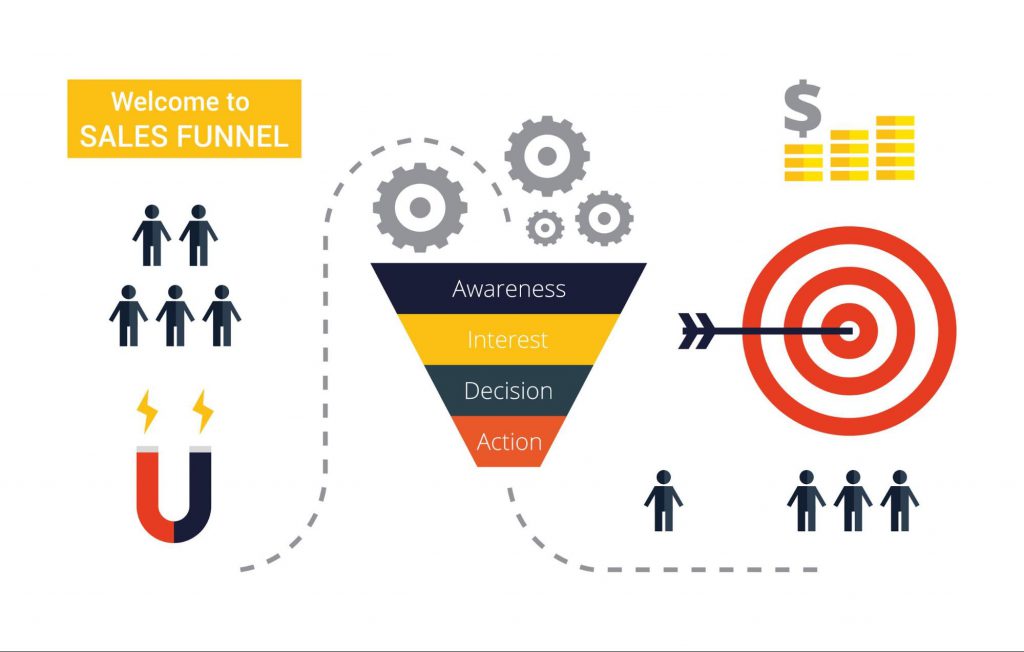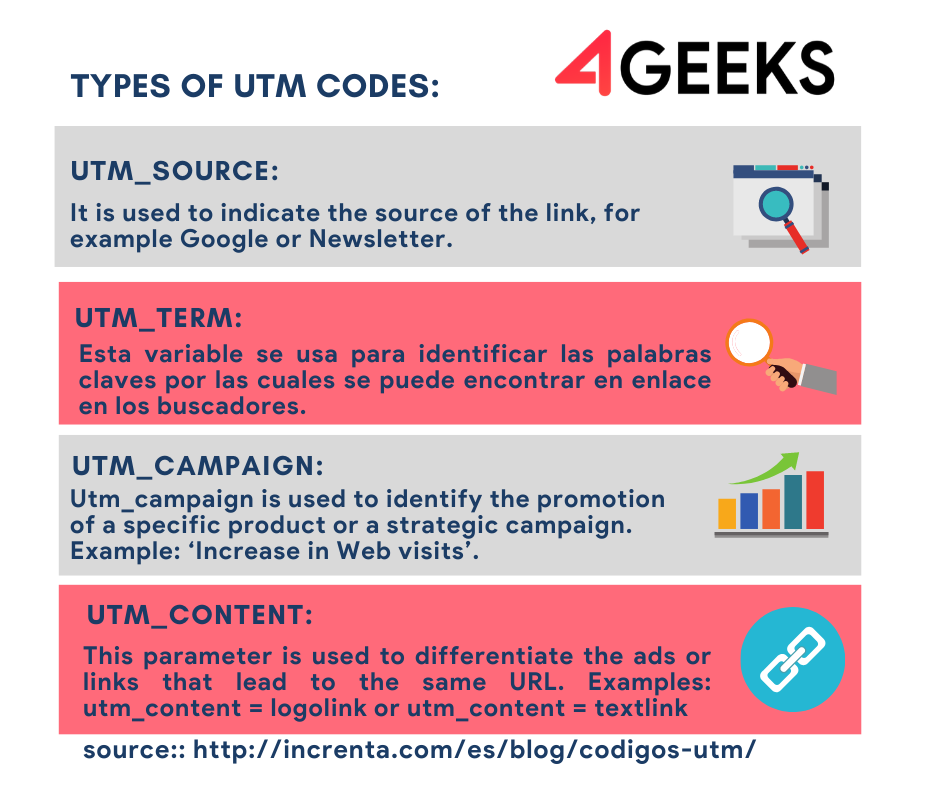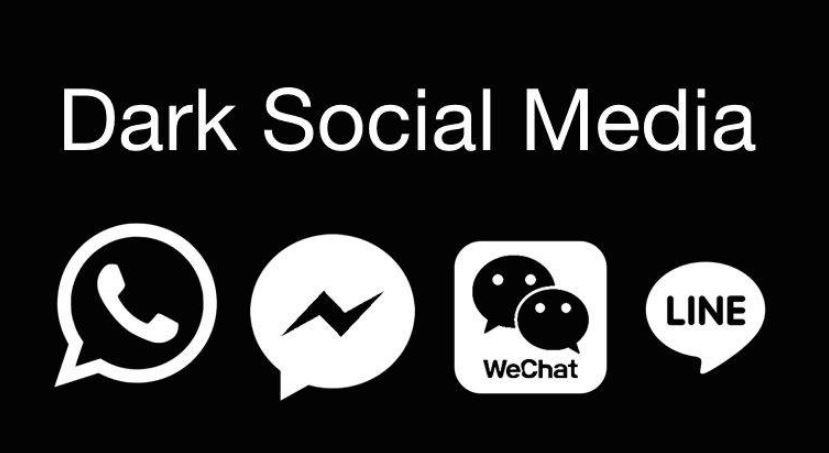What is a marketing funnel? To understand how the dark funnel works, we have to go to the basics of this. Marketing funnels are basically structures of how the process of purchasing something goes.
Basically when a cliente visits your store or web page you want them to do a step by step process, to finish a purchase right?. Well the process of steps are called “conversion” For example buying something at an eCommerce has the following funnel.
- They have to visit the page
- View their products
- Add products to the cart
- Pay
This step by step conversion are called funnels, because at the beginning of every process, there are a lot of people, maybe they are looking at the store, just because of curiosity and they are not interested in really buying anything. As the people continue along to take the steps the funnel narrows, and further the process continues your sales teams it’s going to get involved and hopefully closes the deal.
Obviously this funnel it’s a extra simplified way of how funnels actually work. If you search something like this you can recognize that many of the marketing funnels on the web have way more steps than this. The ultimate goal for a marketing funnel is the visualization of how this process of turning leads into customers work. The main idea of this is to cast as many leads as possible, and then nurturing and given the correct information to help the customers at any stage in the funnel. narrowing down these candidates is every stage of the funnel.

Funnel velocity, and why is it important?
When we refer to funnel velocity we are talking about the rate of range from a potential client (lead) becomes a contact, or how an opportunity can become a customer. This also refers to the velocity moving his way through the funnel.
Funnel velocity can help you define what processes need help or more attention. And also can help define the internal movement of the company. For example let’s say a lead enters into the blogs company and leaves a positive comment. The rate at which someone from the editors blog responds moving the prospect through the funnel into a lead demonstrates, the rate of change.
So… What is the Dark funnel?
So with the concepts a little bit more clear. We are going to dive into the dark funnel, basically the way the clients consume has changed drastically over the years. Marketers have lost insight of how customers look for information or maybe how this information came to them. This evolution has changed how the industry works, marketing teams have to put more effort getting the right information to the customers.
Is This The New Sales Funnel?
Marketing are enhancing their game, this is because most of their research journey is happening off-site for example. Channels that are not controlled by the brand, paid advertising, social (word of mouth).
According to gShift’s they were reporting how their consumers behavior was changing. They noticed that clients reporting prospects were disappearing, and prospect engagement with the website was algo decreasing. Another important thing that the workers of gShift’s notice was that the consumer would come to their website for the first time ready to do the purchase. So they were already informed and prepared.
These “little” but important changes are the “the dark funnel” for marketers. What is happening?. Where are the customers getting their info?. How can I use it for my benefit?. According to Forrester Research, recent research shows that at least 67% of customer journeys occur while consuming off-site content and in some cases, it is as high as 90%.
Forrester also conducted another investigation that told us that “today B2B buyers will find three pieces of content about a vendor for every one piece that marketing can publish or sales can deliver”. A little bit worrying don’t you think?. Are marketers wasting their energy in something that has no case?. Is this part of the forever evolving work adequate to the changes.
How are marketers trying to illuminate the dark funnel?
So like with any problems technology comes to the rescue. Marketers and engineers create different strategies to get information even with the problems that the dark funnel brings. Look at the next examples of how marketers get insights of how the customers search the products.
Smart URL:
So this is really cool a smart URL is a link that contains tracker parameters and analytics to capture data. This is really interesting because these URLs can be programmed to report specific data points, based on the requirements your company is looking for.
The relevance of these URLs is that they can provide insight into the behaviour that is not visible to digital marketers. So how is it that this works ? Basically when content of your website is shared off-site using a smart URL, many systems will cookie that user. So if the data is connected to your marketing automation platform. Then you can potentially have visibility of the engagement of the customer.
UTM Codes:
Maybe you didn’t notice but there are more and more URL that have incorporated UTM codes. Well the funny thing or maybe useful of the UTM codes is that this helps to know the traffic that is coming to your website. Depending on whether the links come from facebook, twitter, Instagram, Google Analytics. UTM codes will help to collect the data and present it more easily.
Every word behind the interrogation sign means or indicates something. For example these are the top five UTM codes:

Adding these pieces of code after the interrogation sign, does not affect the way the Search Engines work. Nor the position at the search results. Only helps your analytical tools to know how many persons came to the site from a certain website.
Influence Marketing:
Influencers yes you heard it right. One way to illuminate the dark funnels is value the opportunity and the trust of relevant highly connected influencers. Obviously you have to search for the right type of influence according to your public. RIght now exists many businesses that offer databases of influencers of different topics.
The downside of this type of marketing funnel is managing the influencer campaigns can be really demanding. Also the measurement is the most critical part of influencer campaigns. Taking into account the type of comments of the quantity of likes it’s not enough to measure the range of the publicity. The real value comes with content engagement analytics to assess the true value of an influencer challenge. Those things are the insights that are difficult to track but useful to know.
Why your business shouldn’t ignore Dark Social
What is dark social?
The one who came up with this concept was Alexis C. Madrigal. The concept refers when a social sharing of a URL occurs outside of what can be measured. Or well an analytics program would attribute these search to and direct traffic (a visit with no referral website). This situation created a gap of information in the media and the way marketers can analyze it . Becauses in reality it’s really weird seeing someone writing a URL by hand.
What really happens is that people are sharing URL and information with email, instant messages, chats like whatsapp or mobile applications like snapchat. Or maybe they are moving from a secure website Moving site (https) to a non-secure site (http) (no a channel but a common cause for no referral data).
Taking this into account everyone is contributing with the growth of dark social. Mostly because we do it without thinking about it very much. Have you ever recommended an online store to your friends, and then you just send an URL to a group chat?…Well congrats you just participated in the great dark social.

3 ways to increase traffic in the dark social ?
1. Create informal content:
First of all when you are thinking about sharing content in the dark social. Or improving your traffic you have to keep in mind the informal situation in which you’re trying to advertise or maybe bring brand awareness. So if we have in the top of our mind that social media is informal, the content in dark social media should be like that.
The idea with this is to avoid context written really formal, or used in your other campaigns, maybe safe that stuff for other media. Take a look on the following ideas:
- Ask a question
- Share a poll or survey
- Share a promotional code
- Share an interactive GIF or video
2. Mobile is really important:
Future marketing strategies have to be focused on mobile devices.
digital media usage grew 4% 2017, to a total of 5.9 hours per day, the statistics say than 55% of that time is spent on mobile devices.
Taking this into consideration the mobile xperience must be really good, that is why mobile applications must be extremely optimized, almost obligatory to have facilities available like widget, share buttons and plugins included.
3. Shorten URL links:
This might be seen as a little bit weird or maybe unnecessary, but if you think about it. Makes sense, if you share an URL what’s easier to copy ?.
Some of the benefits of shortening your webpage URL are: improve customer experience, encourage sharing, looks aesthetically pleasing in comparison.
Trying to optimize your funnels? Look at the AARRR methodology or the pirate metrics:
A- Acquisition:
This part is about how the visitors find your website and how eventually turn into customers. So when people are implementing the pirates methodology. The important part is to look at how many, and how this visitors do the micro conversions, just to the final pating customer. So basically it’s clearly reasonable to take into account every step of the buying funnel.
When you are analyzing the metrics of your page, you should consider the following things: Page visits are not that important, you really want to pay attention when these micro conversions end in the customers watching the video, or adding an item to the cart. Bounce rate is another metric you want to have in the top of your mind, bounce rate measures how many of the visitor got into the page and then just leaves. So basically the interest of the new customers in your content. If they think that is valuable or just not that interesting to continue searching.
So the acquisition phase, works on building awareness and trying to attract the right people. Mostly using the correct metrics to do it. The main goal is to convert this page visits to a sale, what we define as SQL (Sales Qualified Lead).
According to Melanie Balke from the page Medium, the three fundamental questions you want to be asking yourself about your acquisition are:
- What channel is driving the most traffic (#)?
- What channel is driving the most valuable traffic, or performing best (%) in terms of customer conversion?
- What channel has the lowest customer acquisition cost
A- Activation:
So in this step that is the micro conversions worked out and you want to consider the primary conversion metrics that determine success. For example you could use the conversion from your home page to signup to receive the newsletter from that company, or maybe asking the chatbot something. An activated customer already has some awareness of the brand and comes to your website through your acquisition efforts that indicate that they see some value in your product.
In other words is about engaging with the client, with the activation phase. The activated conversion is really when the relationship between the customer and the business really begins. Before that there isn’t an action that engages with the business directly. One way to measure this is based on the visitors who fulfill a desired action: Like subscribing to a podcast channel, or a weekly newsletter.
R- Retention:
Maybe the one of the most triggering of the 5 steps for founders. The retention matter. First of all when we talk about retention we talk about the people who continue using your product after the first time they have consumed the service or product. For example for a SaaS company is when someone who’s subscribed to your software continues using it. Or when we realise blogs people continue reading it.What is the opposite?..Well of course the customer churn, this might be the metric to really review.
Mostly because if there is a lot of customer churn, growth is almost impossible. And it’s really simple how can you grow if a lot of the clients disappear?. According to Harvard Business Review it’s to 5 to 25 times more expensive to acquire a new customer than to retain the existing one. So if we think about its really more star focus some of the campaign in retaining the existing customers
R- Referral:
Having good referral is every marketers and business owner’s dream. That’s because this is the cheapest way to acquire new customers, and genuine. The problem with referral is that it is really difficult to track how many people came with the referral of someone. And also is kind of tricky to incentivize people to promote the company. Many companies like to promote codes, and for businesses that are completely online like SaaS or Ecommerce tracking referral can be a little bit easier.
There are two metrics you can keep closer if you are wanting to know a little about the referral are the Net Promoter Score (NPS). This is a customer loyalty and satisfaction measurement taken from asking customers how likely they are to recommend your product or service on a scale. NPS can be used even as a predictor of business growth, because it indicates how healthy the relationship with clients is.

Other metrics you can have as referral is the Viral Coefficient. This metric according to Geekboard: “Is the number of new users an existing user generates. This metric calculates the exponential referral cycle sometimes called virality. That accelerate company growth.Virality is the inherent incentive for customer to refer friend or colleagues to your company”
R-Revenue:
Last but not least in our pirate metrics, and of course one of the most important revenue. Basically the main goals of every business. The important trick in this is to know how to look at the numbers. Many companies watch the sales overall instead of watching it per unit of business, this is a much more effective and powerful approach to take.
Measuring profitability per customer, you ‘ll be able to discover which customers are breaking even and which are not. This with the aim of discovering which are right messages to send to the different customers.The latest tendencies are growth lops. So this is represented as s system of loops instead of funnels, basically loops are closed systems where the inputs through some process generates more of an output. So can be reinvested in the input.
This can be related to perennial sales that can be explained as a product that keeps reaching new customer week in and week out.
About 4Geeks
Founded in 2012, 4Geeks is a global software engineering and revenue growth consulting firm for Fortune 500, Global 2000 and fast-growing SMBs. Provides top solutions to multiple industries including Retail, Healthcare, Banking & Financial Services, B2B SaaS, Manufacturing and Education. HQ in the USA, and delivery centers across Latin America.




